
Archaeoceratops, meaning "ancient horned face", is a genus of basal neoceratopsian dinosaur from the Early Cretaceous of north central China. It appears to have been bipedal and quite small, reaching 0.9 m (3.0 ft) in length and 10 kg (22 lb) in body mass. It had a comparatively large head but no horns, possessing only a small bony frill projecting from the back of its head.

Leptoceratops is a genus of leptoceratopsid ceratopsian dinosaur from the Late Cretaceous of North America. First found in Alberta in 1910, the type species Leptoceratops gracilis was named in 1914 by Barnum Brown for a partial skull and skeleton of two individuals found in the Scollard Formation. Additional specimens found in the Scollard include a fully complete skeleton and two other very complete individuals alongside it, uncovered in 1947 by Charles M. Sternberg. Specimens from Montana that were among some of the earliest material referred to Leptoceratops have since been moved to their own genera Montanoceratops and Cerasinops, while new material including bonebed remains from the Hell Creek Formation of Montana, and a partial skeleton from the Lance Formation of Wyoming, have been referred to L. gracilis. Combined, Leptoceratops is known from more than ten individuals all from the Maastrichtian deposits of Alberta, Montana and Wyoming, with the complete skeleton represented.

Harpymimus is a basal ornithomimosaurian theropod dinosaur from the Early Cretaceous Period of what is now Mongolia. Unlike later, more derived ornithomimosaurs, Harpymimus still possessed teeth, although they appear to have been restricted to the dentary of the lower jaw.

Micropachycephalosaurus is an extinct genus of basal marginocephalian dinosaur containing only the type species, Micropachycephalosaurus hongtuyanensis. It lived in China during the Late Cretaceous (Campanian) and was found in the Jiangjunding Formation.
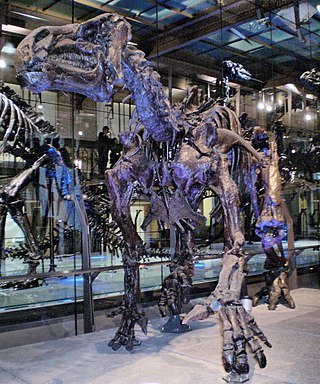
Iguanodontidae is a family of iguanodontians belonging to Styracosterna, a derived clade within Ankylopollexia.

Chaoyangsaurus is a marginocephalian dinosaur from the Late Jurassic of China. It has been dated to between 150.8 and 145.5 million years ago. Chaoyangsaurus belonged to the Ceratopsia. Chaoyangsaurus, like all ceratopsians, was primarily a herbivore.
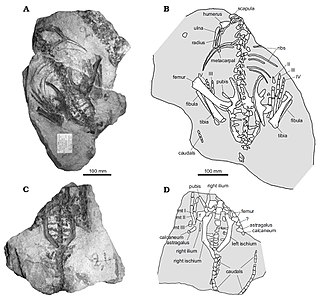
Stenopelix is a genus of small marginocephalian dinosaur, possibly a basal ceratopsian, from the Early Cretaceous of Germany. It lived in the late Berriasian Stage of the Cretaceous period, approximately 140 myr ago. The genus is based on a partial skeleton lacking the skull, and its classification is based on characteristics of the hips.
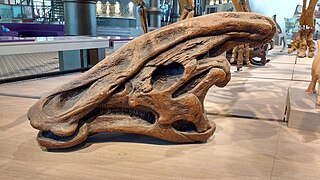
Charonosaurus is a genus of dinosaur whose fossils were discovered by Godefroit, Zan & Jin in 2000, on the south bank of the Amur River, dividing China from Russia. It is monotypic, consisting of the species C. jiayinensis.

Xuanhuaceratops is a genus of dinosaur from the Late Jurassic Period. The genus was in 2006 dated to the Tithonian, 150.8-145.5 million years ago. A member of the family Chaoyangsauridae, it was one of the earliest ceratopsians. The fossils were found in the Houcheng Formation of Hebei Province, northeastern China.

Neornithischia is a clade of the dinosaur order Ornithischia. It is the sister group of the Thyreophora within the clade Genasauria. Neornithischians are united by having a thicker layer of asymmetrical enamel on the inside of their lower teeth. The teeth wore unevenly with chewing and developed sharp ridges that allowed neornithischians to break down tougher plant food than other dinosaurs. Neornithischians include a variety of basal forms historically known as "hypsilophodonts", including the Parksosauridae; in addition, there are derived forms classified in the groups Marginocephalia and Ornithopoda. The former includes clades Pachycephalosauria and Ceratopsia, while the latter typically includes Hypsilophodon and the more derived Iguanodontia.
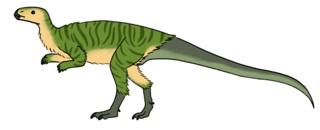
Changchunsaurus is an extinct genus of small herbivorous dinosaur from Early Cretaceous deposits of Gongzhuling, Jilin, China. It is the first named dinosaur genus from Jilin.
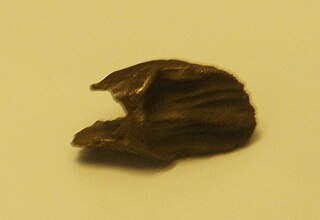
Craspedodon is an extinct genus of ceratopsian dinosaur from the Late Cretaceous Glauconie de Lonzée Formation of Belgium. Only a single species, C. lonzeensis, is known.
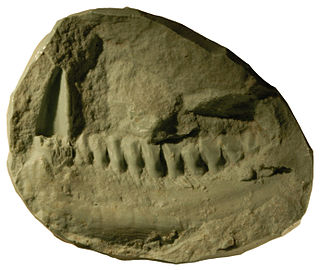
Lycorhinus is a genus of heterodontosaurid ornithischian dinosaur from the Early Jurassic strata of the Elliot Formation located in the Cape Province, South Africa.

Fruitadens is a genus of heterodontosaurid dinosaur. The name means "Fruita teeth", in reference to Fruita, Colorado (USA), where its fossils were first found. It is known from partial skulls and skeletons from at least four individuals of differing biological ages, found in Tithonian rocks of the Morrison Formation in Colorado. Fruitadens is one of the smallest known ornithischian dinosaur, with young adults estimated at 65 to 75 cm in length and 0.5 to 0.75 kg in weight. It is interpreted as an omnivore and represents one of the latest-surviving heterodontosaurids.
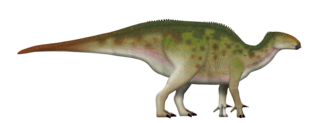
Bolong is a genus of iguanodontian dinosaur known from the Early Cretaceous-age Yixian Formation of western Liaoning Province, China. It lived about 125 million years ago in the earliest Aptian.
Hexing is an extinct genus of basal ornithomimosaur dinosaur known from the Early Cretaceous of northeastern China. It contains a single species, Hexing qingyi.

Aquilops is an early herbivorous ceratopsian dinosaur dating from the Early Cretaceous of North America, approximately 109 million to 104 million years ago. The type species is A. americanus.

Mosaiceratops is a genus of ceratopsian, described by Zheng, Jin & Xu in 2015 and found in the Xiaguan Formation of Neixiang County. Mosaiceratops lived in the upper Cretaceous in what is now the Henan Province of China.
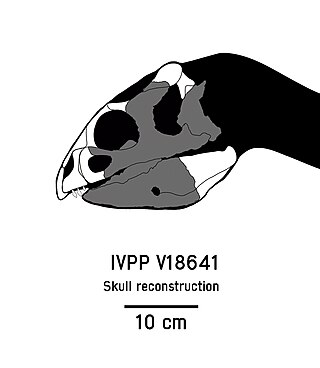
Hualianceratops is a genus of herbivorous ceratopsian dinosaur that lived about 160 million years ago in the Late Jurassic epoch in what is now western China. The single species, H. wucaiwanensis was described in 2015. Its size has been compared to that of a spaniel.

Changmiania is a genus of basal ornithopod dinosaur that lived in what is now China during the Early Cretaceous. It contains a single species, Changmiania liaoningensis.























